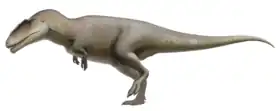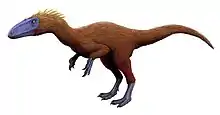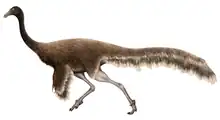Kinnareemimus
Kinnareemimus is a genus of ornithomimosaurian theropod dinosaur from Thailand.[1][2] It is known only from incomplete remains discovered no later than the early 1990s that includes vertebrae, partial pubic bones, metatarsals, and an incomplete fibula. The third metatarsal exhibits a distinctive lateral "pinching", known as the "arctometarsalian" condition, variations of which are found in ornithomimosaurs, tyrannosauroids, troodontids, and caenagnathids. Its remains were collected from the Early Cretaceous Sao Khua Formation, dating to the Barremian stage, at Phu Wiang, Khon Kaen Province. Its early occurrence makes it among the earliest (if not the earliest) ornithomimosaur known, depending on the age of the formation.[3] Buffetaut et al. suggest the fossils of Kinnareemimus may indicate an Asian origin for advanced ornithomimosaurs.[3]

| Kinnareemimus | |
|---|---|
 | |
| Restoration of three Kinnareemimus | |
| Scientific classification | |
| Domain: | Eukaryota |
| Kingdom: | Animalia |
| Phylum: | Chordata |
| Clade: | Dinosauria |
| Clade: | Saurischia |
| Clade: | Theropoda |
| Clade: | †Ornithomimosauria |
| Genus: | †Kinnareemimus Buffetaut et al., 2009 |
| Species: | †K. khonkaenensis |
| Binomial name | |
| †Kinnareemimus khonkaenensis Buffetaut et al., 2009 | |
| Synonyms | |
| |
The genus was first described by Eric Buffetaut, Varavudh Suteethorn and Haiyan Tong in 2009 and the type and only species is Kinnareemimus khonkaenensis. It was named in honor of Kinnaree, "graceful beings of Thai mythology, with the body of a woman and the legs of a bird, said to inhabit the depths of the legendary Himmapan Forest, by allusion to the bird-like feet of this dinosaur".[3] The name "Kinnareemimus" was first mentioned in a 1999 paper by Sasithorn Kamsupha, and (as "Ginnareemimus") in a publication by Ryuichi Kaneko in 2000.
See also
References
- Buffetaut, Eric; Suteethorn, Varavudh (June 1999). "The dinosaur fauna of the Sao Khua Formation of Thailand and the beginning of the Cretaceous radiation of dinosaurs in Asia" (PDF). Palaeogeography, Palaeoclimatology, Palaeoecology. 150 (1–2): 13–23. Bibcode:1999PPP...150...13B. doi:10.1016/S0031-0182(99)00004-8.
- Sales, Marcos A. F.; Lacerda, Marcel B.; Horn, Bruno L. D.; de Oliveira, Isabel A. P.; Schultz, Cesar L. (1 February 2016). "The 'χ' of the Matter: Testing the Relationship between Paleoenvironments and Three Theropod Clades". PLOS ONE. 11 (2): e0147031. Bibcode:2016PLoSO..1147031S. doi:10.1371/journal.pone.0147031. PMC 4734717. PMID 26829315.
- Buffetaut, Eric; Suteethorn, Varavudh; Tong, Haiyan (2009). "An early 'ostrich dinosaur' (Theropoda: Ornithomimosauria) from the Early Cretaceous Sao Khua Formation of NE Thailand". In Buffetaut, Eric; Cuny, G.; Le Loeuff, Jean; Suteethorn, Varavudh (eds.). Late Palaeozoic and Mesozoic Ecosystems in SE Asia. Geological Society of London. pp. 229–243. doi:10.1144/SP315.16. ISBN 978-1-86239-275-5. S2CID 128633687.
External links
- Brief description Archived 2011-07-17 at the Wayback Machine on the Dinosaur Mailing List

.jpg.webp)












